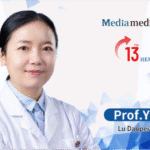
On August 22–23, 2025, the 13th Lu Daopei Hematology Conference was held in Beijing, jointly organized by the Beijing Health Promotion Association and the Guangzhou Kapok Oncology & Rare Disease Foundation, and hosted by the Beijing Lu Daopei Hematology Institute. The event brought together top global hematology experts and focused on hematopoietic stem cell transplantation, cell therapy, and precision diagnosis and treatment of hematologic malignancies, offering an in-depth, high-level academic exchange for over a thousand participants.
During the conference, Professor Francesca Lorraine Wei Inng Lim, Chief Medical Officer at ACTRIS and practicing at Singapore General Hospital, delivered an illuminating talk on the ‘Cell Therapy Landscape in Singapore.’ Following her presentation, Hematology News invited Professor Lim to expand on key questions, sharing valuable perspectives for advancing cell therapy practice and policy.
PART 1 — Clinical Accessibility, Local Manufacturing, and Regulatory Framework
Professor Lim highlighted that Singapore enjoys a unique advantage in developing cell and gene therapy (CGT) by drawing on advanced experience from the U.S., Europe, and China. However, she emphasized that the global leadership in CGT technology still resides largely in these regions. Singapore’s clinical teams have invested heavily in international training. Physicians have undergone fellowships at leading global CAR-T centers such as MD Anderson Cancer Center, Memorial Sloan Kettering Cancer Center, and King’s College London. The nursing teams have also received standardized training to ensure safe and regulated application of cell therapies.
On the infrastructure front, Singapore’s national GMP manufacturing platforms have ample capacity. The newly commissioned ACTRIS facility functions as a multi-purpose hub capable of handling a range of cell therapy products simultaneously — a milestone made possible by strong government foresight and policy support. A dual-licensing system (manufacturing license + GMP certification) provides robust institutional safeguards for product quality, leaving no significant infrastructure gaps. Singapore’s regulatory framework is evolving in tandem with technology. Professor Lim noted that clear guidance documents have been developed to regulate the introduction, translation, and clinical application of novel CGT products, ensuring compliance with stringent safety and quality standards. She cautioned that future challenges will arise with next-generation technologies such as iPSC-derived products, which will require entirely new quality control and clinical release standards.
She also underscored the need for vigilance when applying cutting-edge therapies to critically ill patients with aggressive hematologic malignancies, as the long-term toxicity profiles of many products remain poorly understood. Furthermore, she stressed that the high cost of treatment remains a major barrier: therapies priced in the hundreds of thousands of dollars pose ethical challenges to broad clinical adoption.Ultimately, Professor Lim called for leveraging Singapore’s accumulated CAR-T experience to build a ‘knowledge transfer loop’ that will enable the safe and efficient rollout of future therapies, strengthening Singapore’s position as a regional hub for cell therapy.
PART 2 — The “Hub-and-Spoke” Model for Cross-Border Cell Therapy
Singapore General Hospital has long used a ‘hub-and-spoke’ model for bone marrow transplantation, treating patients from neighboring countries such as Vietnam and allowing them to return home for follow-up care managed by local hematologists. This experience has been extended to CAR-T programs.International patients (from India, Vietnam, etc.) may either visit Singapore directly or have their cases presented to the Singapore team through their referring physicians. Importantly, multidisciplinary tumor boards (MDTs) — including transplant physicians, oncologists, ICU and infectious disease specialists — are convened to review each case before acceptance.Professor Lim stressed that capacity-building in the referring country is crucial to ensure patients continue to receive standardized care upon return. Modern telemedicine solutions such as Zoom and Microsoft Teams have greatly improved coordination, enabling real-time joint consultations and more seamless care compared to traditional email-based communication.
For patients entering clinical trials, ethics committee procedures are already mature, but for compassionate-use cases of innovative therapies, rigorous institutional review board (IRB) evaluation is mandatory. This ensures patients fully understand potential risks and benefits and safeguards ethical implementation of these last-resort treatments.
PART 3 — Singapore’s Role in R&D, Commercialization, and Regional Collaboration
Looking ahead, Professor Lim sees Singapore playing a pivotal role in bridging academic research with industrial commercialization. She emphasized that academic institutions alone cannot manage the full pipeline from product development to market entry — industry collaboration is indispensable.
Given Singapore’s population of only about six million, large-scale single-center trials are impractical. Professor Lim advocated for multi-center and cross-border collaborations with partners in Malaysia, Vietnam, and China to generate robust data supporting regulatory approval and regional rollout. Finally, she called for deeper integration among academia, industry, and regulatory bodies, supported by favorable government policies. Only through this tripartite collaboration can Singapore establish a full innovation-to-translation ecosystem and ensure safe, equitable access to next-generation cell and gene therapies.

